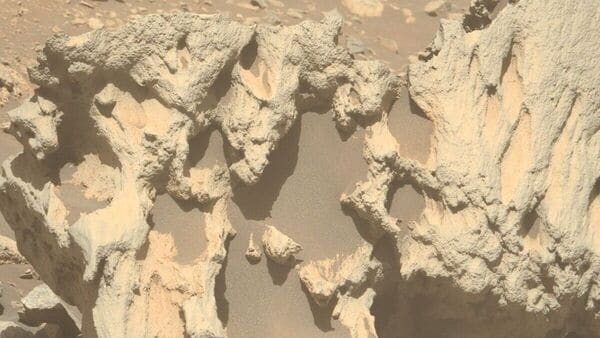NASA’s Perseverance rover has discovered a unique iron-nickel rock on Mars that scientists suspect could be a meteorite from elsewhere in our solar system.
Key Findings
- Unusual iron-nickel rock discovered in Mars’ Vernodden region
- Rock named “Phippsaksla” measures about 80 centimeters across
- Distinct carved appearance stands out from surrounding terrain
- SuperCam analysis reveals high iron-nickel content
The rover identified the striking, sculpted rock during its survey of the Vernodden bedrock. Measuring approximately 80 centimeters across, Phippsaksla’s tall, carved appearance contrasted sharply with the flat, fractured terrain around it.
Perseverance’s SuperCam instrument confirmed the rock contains high levels of iron and nickel – a signature characteristic of iron-nickel meteorites that typically form in the cores of large asteroids. This composition suggests the rock may have originated beyond Mars before arriving on the planet’s surface.
NASA scientists emphasize that further analysis is needed to confirm whether Phippsaksla is indeed a meteorite. If verified, it would join other meteorites previously examined by Mars rovers.
Perseverance Mission Overview
Launched on July 30, 2020, and arriving on Mars on February 18, 2021, the Perseverance rover carries seven advanced scientific instruments with four primary objectives:
- Search for signs of ancient microbial life
- Study Martian geology and climate
- Collect and cache rock samples for future return missions
- Test technologies for upcoming human exploration
Weighing just under 2,300 pounds, the car-sized rover represents a significant advancement in Mars exploration technology.
NASA’s Broader Exploration Strategy
Perseverance is a crucial component of NASA’s Moon to Mars exploration architecture. Through the , the space agency plans to establish sustained human presence around the Moon by 2028, serving as preparation for eventual human missions to Mars.
Managed by NASA’s Science Mission Directorate and Jet Propulsion Laboratory, the Perseverance mission continues to enhance our understanding of Mars’ ancient environments – and potentially, the celestial visitors that have journeyed there from deep space.




